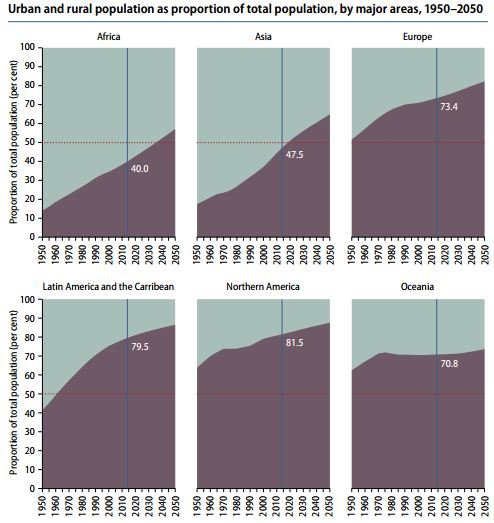With more than 7.3 billion people on the planet today, the world may have more than 10 billion people in the next 25 years. Even more amazing? The world could have way more by the end of the century — or it could start shrinking. As with many expert predictions, it all depends.
It's pretty universally agreed that humanity's numbers will continue to grow in the near term. What's unclear is what will happen in the second half of the cenutry. By some estimates there could be almost 14 billion people on planet earth by 2100. The good news is that most experts believe that in the second half of the century, the population will peak at just over 11 billion before it will actually decline. And instead of declining because of disease or massive natural disasters, the reasons for decline may be simple personal choice.
The rising number of people on the planet should not surprise anyone alive for the last century. In 2011, the world crossed the 7 billion people mark. Incredibly, that was double the global population only 43 years before. Yes, that means the world added 3.5 billion people in just 43 years.
More so, the global growth rate is accelerating. The world is adding another billion people about every 12 years.
Why should you care? Monday is World Population Day, an event first observed by the UN Development Programme in 1989 to raise awareness of population related issues. This year’s UN theme is “Investing in Teenage Girls,” which the UNFPA has helped explain through this nifty animation.
Yet this video may dive too far into the issue. To truly understand world population, it’s important to visualize the sheer size of the growth, where it’s happening and how it is changing our global identity.
Here is a handy set of charts to get you settled into our crowded world.
Humanity has grown by leaps and bounds in the last 100 years. This chart really puts that in perspective. Before the 1800s, there was less than 1 billion people total. By some estimates, the people alive today account for over 5% of all human beings who have ever lived.
This shows how some of the world’s largest and most influential nations have grown over the last 500 years. (Pro tip: Compare this to a chart later on that looks toward population growth in the rest of the century)
Around the world humanity is growing in every type of country and environment.

And everywhere, humanity is getting more urbanized. For the first time in our species’ history, humanity became more urban than rural in about 2010. Amazing considering at the start of the 1800s only 3 percent of humanity lived in cities.
And that urbanization is happening fastin many developing nations. Check this chart out that shows how many people are being added to some major cities each hour.
 Estimated urban growth per hour through a combination of natural internal growth and migration in selected world cities.
Estimated urban growth per hour through a combination of natural internal growth and migration in selected world cities.
Now that you understand the world we live in, what will it look like in the future?
The UN has taken a pretty strong guess, though being scientists they liked to hedge their bets.

The chart above lays out three statistical probabilities. If the world continues with a “high fertility rate,” which simply means having a lot of babies per potential mother, then global population could swell to 13 or 14 billion by the year 2100.
Most experts think this is unlikely. Most predictions look at the UN’s “medium” variant, which predicts that world population will peak and then decline in the next 100 years.
Cities will be the main destination for people.

The growth will not be spread evenly across the world.

While population growth in Africa will lead the world the continent as a whole’s growth rate will actually decline.

According to the UN’s World Population Prospects: The 2015 Revision:
The world leader in population, China, will actually lose the most amount of people during the 21st century. China is nearing its peak population as life expectancy has increased while fertility rates have fallen sharply in large part because of the one-child policy that was in effect from about 1978 through 2015.

Take a look at how some of the world’s most influential nations will fare in terms of population.
Humanity is growing but the world is not. An increased population will put strains on resources ranging from energy to food. Growing cities will demand flexible, innovative solutions to provide an improving quality of life to the planets fast growing number of urbanites.
World Population Day is a time to reflect on where humanity has come, how we will grow, and what kind of world we need to build for our increasing global family.